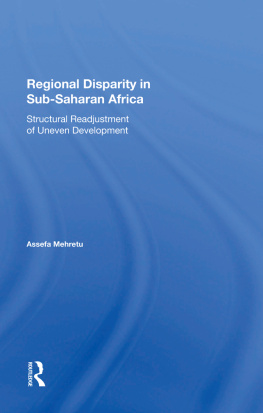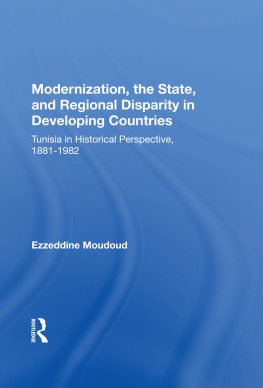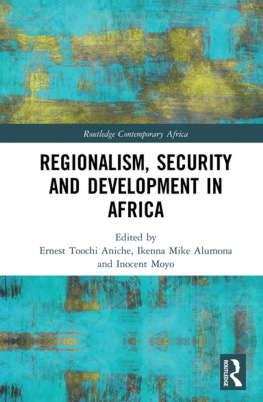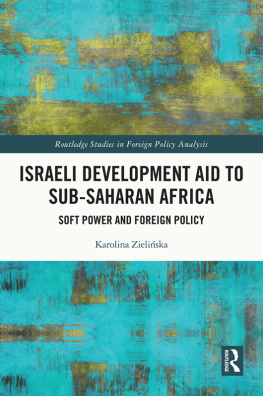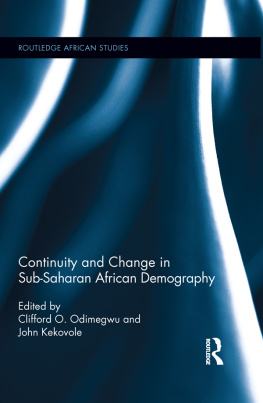Regional Disparity in Sub-Saharan Africa
Regional Disparity in Sub-Saharan Africa
Structural Readjustment of Uneven Development
Assefa Mehretu
First published 1989 by Westview Press
Published 2019 by Routledge
52 Vanderbilt Avenue, New York, NY 10017
2 Park Square, Milton Park, Abingdon, Oxon OX14 4RN
Routledge is an imprint of the Taylor & Francis Group, an informa business
Copyright 1989 by Taylor & Francis
All rights reserved. No part of this book may be reprinted or reproduced or utilised in any form or by any electronic, mechanical, or other means, now known or hereafter invented, including photocopying and recording, or in any information storage or retrieval system, without permission in writing from the publishers.
Notice:
Product or corporate names may be trademarks or registered trademarks, and are used only for identification and explanation without intent to infringe.
Library of Congress Cataloging-in-Publication Data
Assefa Mehretu.
Regional disparity in sub-Saharan Africa: structural readjustment
of uneven development / by Assefa Mehretu.
p. cm.(Westview special studies on Africa)
Bibliography: p.
Includes index.
ISBN 0-8133-7733-1
1. Africa, Sub-SaharanEconomic conditionsRegional disparities.
2. Africa, Sub-SaharanEconomic policy. I. Title. II. Series.
HC800.A88 1989
338.966dc19 89-30807
CIP
ISBN 13: 978-0-367-28545-6 (hbk)
To Doree
| Maps |
| Economic regions of Sub-Saharan Africa |
| Figures |
| Tables |
This book is an outcome of research on African development from the standpoint of economic geography which I have been undertaking over the last four years. The initial impetus for the research was a social science grant from the Rockefeller Foundation which enabled me to write most of the preliminary draft of the book during a sabbatical in 1984/85 which I spent at the University of Zimbabwe as Visiting Professor of Geography. A good deal of the latter part of the book was written in September of 1985 at the Rockefeller Foundation Study and Conference Center in Bellagio, Italy, where I spent three weeks as a member of the Reflections on Development Fellows of the Foundation from Africa and Asia.
My principal objective in this work is to highlight and reflect on the principal sociospatial constraints to development in Sub-Saharan Africa (SSA) that have been largely ignored by development research and planning. The work especially tries to draw attention to postcolonial anti-development biases in spatial form and process whose combined impact on patterns of production and distribution I have referred to as structural hegemony. I have used structural hegemony as a systemic construct to encompass social and spatial factors of control and domination that collectively militate against equity in political participation, access to opportunities for development, and free enterprise in competitive markets. My use of the term structural hegemony is not limited to characterize postcolonial biases and distortions connected with the imperfections of the neoclassical framework. It is also intended to include all non-democratic forms of regimentation, especially those that emanate from totalitarian regimes in so-called socialist states in Sub-Saharan Africa. The worsening spatial polarity in levels of living between primate cities and rural hinterlands in Sub-Saharan Africa is attributed to structural hegemony exercised by typical core characteristics in postcolonial states to the detriment of the majority in the countryside. I have argued that once the effect of distance decay has been accounted for, the remaining unevenness in space of benefits from development in Sub-Saharan nations is more a function of structural hegemony than it is of competitive inequality in access to the means of production. I also contend that the lack of success over the last three decades has been due not only to the intrinsic weaknesses of the applied neoclassical-development models, but also to the dominance of structural hegemony, which has been undercutting forces of equitable allocation of opportunities and of benefits. A principal thrust of my argument is to indicate the pervasive force of structural hegemony in the life of ordinary citizens in SSA, which constrains their alternative options to face the everchanging conditions around them while at the same time increasing the uncertainties and risks associated with their political and economic stability. For this reason, the policy dimensions of the study give special attention to the role which geography can play in a multidisciplinary approach to resolve structural hegemony by suggesting alternative regional concepts to redress and reverse postcolonial inertia that has perpetuated inequitable and destabilizing polarities in levels of living.
I would like to express my gratitude to the Rockefeller Foundation for making the research possible by granting me a social science fellowship to work on the book and other related research projects in East Lansing, Harare and Bellagio. My heartfelt thanks go to Gary Manson, Chair, Department of Geography, Michigan State University (MSU), for his unwavering support and encouragement. He not only made it possible for me to take a study leave and work at the University of Zimbabwe, but he also raised the additional funds I needed to supplement the Rockefeller grant. I would also like to extend special thanks to Carl Eicher and David Wiley for all their support in facilitating my research leave with a visiting appointment at the University of Zimbabwe. I want to thank Chris Mutambirwa, Chair of Geography at the University of Zimbabwe, for the superb assistance I was given by his department staff and, above all, for making the sojourn in Zimbabwe most enjoyable and rewarding not only for me but also for my family. Thanks are also due to my MSU Geography colleagues David Campbell and Bruce Pigozzi and to graduate students in the department who have been exposed to some of the ideas in the book and have kindly offered suggestions for improvement. I wish to extend my thanks to Rex Honey, Geography, University of Iowa, and his graduate students who read an earlier version of the section on structural hegemony and offered me very critical comments that helped me clarify some points. However, only I will be responsible for faults and errors that may still remain in the work.
I want to express many thanks to Harriet Ashbay for her patience and fortitude in working through my numerous editions by spending countless hours on the word processor. My thanks are also due to Amy Broesamle for editing and reformatting the list of references, Ellen White and Ron Tiefenbach for the graphic and cartographic work, and Mike Lipsey for teaching me how to negotiate with the word processor. Finally, I want to thank my wife, Doree, to whom I remain forever grateful for her love, support and patience.
Assefa Mehretu
The Nature of the African Development Crisis
African economic conditions in the 1980s clearly demonstrated that the methods used for progress and development over the last two decades have not performed as well as expected. Economic planning and application of various systems of agricultural and industrial development that included export crop production, import substitution, community development, and various rural development designs, did not meet intended goals. That is not to say that nothing has been achieved. Some progress has been seen in agriculture, particularly in countries that had more liberal economic policies. The disappointments were felt mostly in four principal areas. First, African populations, although mostly rural, have surprisingly lost their capacity to feed themselves and have become increasingly dependent on food imports and food aid (FAO, 1986a, pp. 2-3; FAO, 1986c, pp. 1-11; Eicher, 1986, pp. 242-275). This, by default, has produced a population problem for Africa. Second, no tangible progress has been made toward industrializing the African economy and reducing its heavy dependence on raw material exports as well as saving valuable foreign exchange through viable import substitution (Hawkins, 1986, pp. 279-307). Third, the distribution of development benefits, which favored the primate cities and related urban locations (Riddell, 1985; Chambers, 1983, pp. 103-139), has caused rapid increases in rates of urbanization far beyond the capacity of the urban economy to sustain. Finally, the postcolonial process of accumulation has rendered democratic processes of self determination and of equitable distribution of social costs and social benefits inoperable in Africa. Both economic surpluses and political power continue to be concentrated in very few hands in much the same way as they did in colonial Africa (see Callaghy, 1988, pp. 67-99; Hyden, 1986, pp. 44-54; Prebisch, 1984, pp. 185-186).



